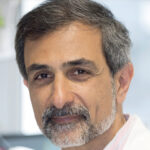About
Symmetric and asymmetric divisions also play key roles during growth and regeneration. We showed previously that asymmetric template DNA strand cosegregation takes place in a subpopulation of adult muscle stem cells (7). More recently we demonstrated that cells performing biased DNA segregation can be isolated prospectively in the Pax7-High expressing fraction using Tg:Pax7-nGFP mice (5). Significantly, old template DNA strands are inherited by the self-renewing stem cell and this process engages all chromosomes (5). Notably, old DNA template strands are inherited by the daughter cell fated to be stem (Pax7+), whereas new DNA strands are inherited by the daughter cell that will differentiate (Myogenin+). Therefore muscle cell fate in asymmetrically dividing cells correlates with asymmetric DNA segregation (5, Figure 2). How the balance between asymmetric and symmetric cell divisions relates to the stem cell niche is being investigated at the single cell level on micropatterns. We also performed transplantations of satellite cells and demonstrated their long term capacity to self-renew after 6 rounds of serial transplantations in immunocompromised mice (5).


